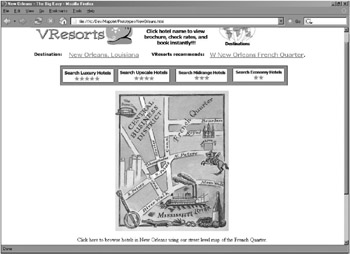Visual Acceptance Testing
A key part of ICONIX Process is to begin with a prototype of the UI. As we discuss in Figure 6-1).

Figure 6-1: A web page mock-up for the ESRI mapplet project
It’s important to note that the screenshot in Figure 6-1 was produced as quickly as possible. It doesn’t need to be perfect, glossy, or fine-tuned—it isn’t a final product, and it might not end up being entirely similar to the final product. But it gets the team thinking at an early stage about what the product will look like, how it will behave, how the user will interact with it, and so on. With this in mind, the New Orleans destination page in Figure 6-1 was slapped together using graphics “borrowed” from a variety of sources, rather like a photofit. When the project begins to pick up steam, the drawing of the New Orleans map will be replaced by a preview JPEG of the map instance, which will link to a new page containing the active map.
UI prototypes like this one can be used as an informal kind of visual acceptance testing. When we replace the static map of New Orleans with a preview JPEG of the mapplet, and we can browse brochures and book hotels through the mapplet, then it passes the acceptance test.[2.]
The following additional instructions were given to the team by the customer in an e-mail:[3.]
In most cases I’ll be looking for a street-level map centered on the recommended hotel, defaulted to display Luxury and Upscale hotels and with options to switch on Midrange and Economy hotels, etc.
One other really useful feature that I’m envisioning on every map page is the ability to just enter a zip code anywhere in the US and set the map to the zip code boundaries. Unless I miss my guess, this is “low-hanging fruit” (i.e., very easy for you to build) … so if I’m right, maybe we can go for it. This way, if you had a business meeting in New Orleans that was not in the French Quarter, you could just jam in the zip code and boom, there’s the map. Also, if you were looking at the New Orleans map and suddenly remembered you had another meeting in Chicago, you just jam in that zip code and you’re zapped into a Chicago map.
After the first modeling iteration (which we cover in the next section), the team was due to create a working prototype of the hotel mapplet.[4.]
[2.]If the suspense is really killing you, feel free to check ahead to Figure 6-12 to see if the finished screenshot for release 1 passes our visual acceptance test.
[3.]Note that in this case, “optimizing for communication” involved allowing the (very busy) off-site customer to supply direction to the programmers via e-mail.
[4.]Interestingly, this was written at around the time wildfires were spreading through the state of California in October 2003. At one stage, the fires had spread to within 10–15 miles of the ESRI offices—so it was touch and go for a while whether we were going to see the next iteration at all!
EAN: 2147483647
Pages: 97
- Challenging the Unpredictable: Changeable Order Management Systems
- The Second Wave ERP Market: An Australian Viewpoint
- Data Mining for Business Process Reengineering
- Intrinsic and Contextual Data Quality: The Effect of Media and Personal Involvement
- Development of Interactive Web Sites to Enhance Police/Community Relations